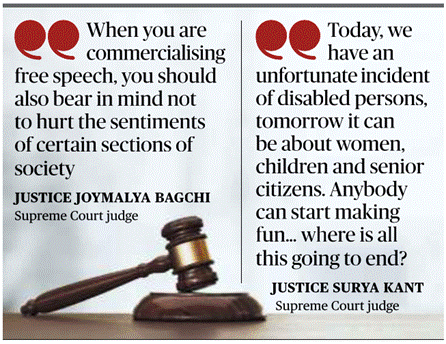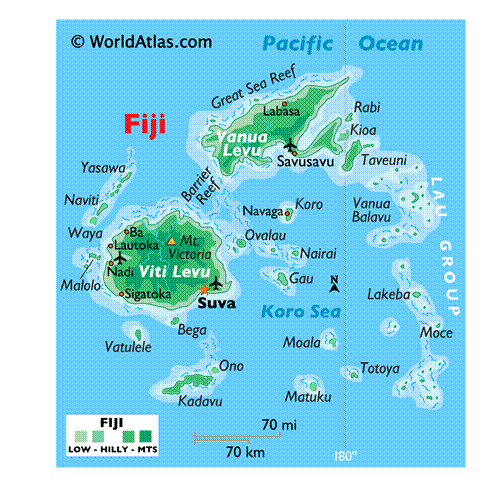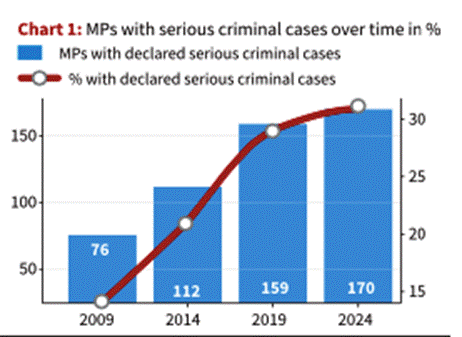Content
- SC asks Union govt. to draw up rules on social media conduct
- India, Fiji call for open Indo-Pacific region, agree to deepen defence ties
- Stealth frigates Udaygiri, Himgiri to join Navy today
- Like other relics, India’s fossils are at high risk of being sold abroad
- About 30% of MPs and MLAs face serious criminal cases
- What does the new online gaming Act outline?
- Videshi in One’s Own Country: India’s Internal Diasporas
SC asks Union govt. to draw up rules on social media conduct
Basics
- Free Speech (Article 19(1)(a), Constitution of India): Fundamental right but not absolute.
- Reasonable Restrictions (Article 19(2)): Speech can be regulated in the interest of decency, morality, public order, defamation, etc.
- Case Context:
- Comedians faced complaints for insensitive jokes about persons with disabilities.
- Petition filed by an NGO (SMA Cure Foundation).
- Question before SC: How to balance freedom of expression with dignity of vulnerable groups in a diverse society.
Relevance : GS 2(Judiciary , Constitution )

Supreme Court Observations
- Commercialisation of Free Speech: Social media influencers use speech for profit; such speech can amplify harm.
- Impact on Communities: Speech must respect dignity of persons with disabilities, women, children, senior citizens, and minorities.
- On Humour: Recognised humour’s value, but cautioned that levity should not cross into hurtful stereotyping.
- Main Concern: Insensitive jokes undermine the constitutional goal of inclusion for disabled persons.
- On Guidelines:
- Need clear rules with specific and proportionate consequences for violations.
- Guidelines must draw a line between free speech vs. prohibited/hurtful speech.
- Consequences must not be “empty formalities.”
Government’s Position (Attorney-General R. Venkataramani)
- Objective: Focus on sensitisation of social media users, not censorship.
- Accountability: Violators must take responsibility.
- Observation: Many online blogs/podcasts “feed egos” rather than serve public good.
Legal Classification of Speech (as noted by SC)
- Free Speech – protected expression.
- Commercial Speech – profit-oriented, subject to regulation.
- Prohibited Speech – unlawful (hate speech, obscenity, etc.).
- Overlap Concern: Online comedy shows and influencer content often blend commercial and potentially prohibited speech.
Wider Issues Highlighted
- Influence of Social Media: What influencers say shapes attitudes of an entire generation.
- Dignity vs. Expression: Vulnerable groups risk mockery, reinforcing exclusion.
- Precedent Risk: Today disability, tomorrow jokes on women/children/elders → slippery slope of insensitivity.
Directions by Court
- Comedians asked to tender unconditional apology through their shows.
- Centre asked to frame social media guidelines in consultation with stakeholders (National Broadcasters and Digital Association).
- Case listed again in November 2024.
Comprehensive Analysis
- Constitutional Balance:
- Court is not curtailing free speech but seeking a balance with Article 21 (Right to Life with Dignity).
- Evolving Jurisprudence:
- Expands interpretation of restrictions on speech in digital age.
- Treats influencers as responsible public figures, not private speakers.
- Policy Implications:
- Rules may cover podcasts, comedy shows, reels, stand-ups with commercial intent.
- Likely to emphasise sensitisation, grievance redressal, proportionate penalties.
- Global Parallels:
- EU’s Digital Services Act (2022): accountability of online platforms for harmful content.
- U.S.: Free speech absolute but limited by hate speech jurisprudence in practice.
- India is moving towards a hybrid model: protect speech but curb offensive, discriminatory content.
Way Forward
- Guideline Formation: Involve civil society, disability rights groups, digital platforms.
- Sensitisation Campaigns: Make influencers ambassadors of inclusion.
- Stronger Grievance Redressal: Quick complaint resolution on platforms.
- Graduated Penalties: Apology → Fines → De-platforming for repeated violations.
- Judicial Oversight: SC ensures rules don’t become tools for censorship.
India, Fiji call for open Indo-Pacific region, agree to deepen defence ties
Basics
- Indo-Pacific Region:
- Geopolitical concept spanning the Indian Ocean to the Pacific Ocean.
- Central to global trade, maritime security, and strategic competition (notably India–China–US dynamics).
- Fiji’s Position:
- An island nation in the South Pacific.
- Strategically located within the “Blue Pacific Continent,” often seen as a gateway to Pacific island states.
- India–Fiji Relations:
- Historical ties through Indian diaspora in Fiji (approx. 40% of Fiji’s population).
- Enhanced defence ties since 2017 Defence Cooperation MoU.
- Member of the Forum for India-Pacific Islands Cooperation (FIPIC).
Relevance : GS 2(International Relations)

Key Announcements during Rabuka’s Visit (2024)
- Defence Cooperation:
- Training & equipment support for Fiji’s maritime security.
- Capacity building for Fijian armed forces.
- Cooperation on UN peacekeeping, military medicine, and White Shipping Information Exchange.
- Planned Indian naval ship port call to Fiji for enhanced interoperability.
- Two ambulances gifted to Fiji’s military; Defence Wing to open at India’s High Commission in Suva.
- Strategic Statements:
- Both countries reaffirmed support for a “free, open, inclusive, secure, and prosperous Indo-Pacific”.
- India sees Fiji as a hub in its Pacific outreach.
- Implicit balancing of China’s growing influence in Pacific islands (notably naval base concerns).
- Other MoUs Signed:
- Super-specialty hospital in Fiji.
- Migration & mobility agreement.
- Cybersecurity cooperation, including a new training cell in Fiji.
- Strengthening counter-terrorism cooperation.
Strategic Significance
- For India:
- Expands India’s strategic footprint in the Pacific islands.
- Strengthens FIPIC and Act East + Indo-Pacific Oceans Initiative (IPOI).
- Counters China’s attempts to gain military bases and leverage over Pacific states.
- Enhances India’s image as a development partner and security provider.
- For Fiji:
- Gains military, maritime, and cyber capacity-building support.
- Protects its Exclusive Economic Zone (EEZ) and maritime resources.
- Diversifies security partnerships beyond China.
- Benefits from Indian aid in health, mobility, and counter-terrorism cooperation.
- For Indo-Pacific:
- Strengthens the principle of open seas, freedom of navigation, and rules-based order.
- Reinforces coalition-building among like-minded states (India, Fiji, Japan, Australia, US).
- Highlights role of smaller island nations as pivotal players in regional security.
Underlying Geopolitics
- Fiji’s PM Sitiveni Rabuka has earlier opposed China’s naval base plans in the Pacific islands.
- Joint India–Fiji statement subtly signals alignment with Quad principles.
- India balances soft power (diaspora, hospital, training) with hard power (naval visits, defence cooperation).
- Fiji leverages partnerships to avoid strategic overdependence on China.
Stealth frigates Udaygiri, Himgiri to join Navy today
Basics
- What are frigates?
- Medium-sized warships, versatile for escort, patrol, anti-submarine, and surface warfare roles.
- Crucial for maintaining maritime security and projecting naval power.
- Project 17A:
- Follow-on of the Project 17 (Shivalik-class) stealth frigates.
- Envisages 7 stealth frigates, designed by the Warship Design Bureau (WDB).
- Key focus: stealth features, modular construction, advanced sensors and weapons, and high indigenous content.
- Shipbuilders involved:
- Mazagon Dock Shipbuilders Ltd. (MDL), Mumbai – builder of Udaygiri.
- Garden Reach Shipbuilders & Engineers (GRSE), Kolkata – builder of Himgiri.
Relevance : GS 3(Defence , Internal Security)

Key Highlights of Commissioning
- First-ever simultaneous commissioning of two frontline warships built at different shipyards.
- Udaygiri is the 100th vessel designed by WDB, marking 50 years of indigenous design capability.
- Udaygiri was delivered faster due to modular construction techniques.
- Names Udaygiri and Himgiri revive the legacy of earlier Indian Navy warships.
- Both join the Eastern Fleet, enhancing presence in the Indian Ocean.
Technical Features
- Stealth Capabilities: Reduced radar, infrared, acoustic, and magnetic signatures.
- Propulsion: Combined Diesel or Gas (CODOG) system.
- Combat Systems: Advanced weaponry and modern sensor suite for anti-air, anti-surface, and anti-submarine warfare.
- Automation: Integrated Platform Management System for efficient operations.
- Indigenisation: ~75% indigenous content, including Indian-made weapons and sensors, supported by MSMEs.
Strategic Significance
- Blue-Water Navy Expansion: Capable of sustained operations in distant waters, bolstering India’s regional and global maritime role.
- Aatmanirbhar Bharat: Strengthens India’s indigenous defence manufacturing ecosystem.
- Inter-Yard Collaboration: Demonstrates coordination between MDL and GRSE, a milestone in India’s shipbuilding sector.
- Force Multiplier: Enhances India’s ability to safeguard Sea Lanes of Communication (SLOCs) and counter maritime threats in the Indian Ocean.
- Symbolic Continuity: Heritage revival through warship names reflects India’s naval traditions.
Like other relics, India’s fossils are at high risk of being sold abroad
What are Fossils?
- Definition: Preserved remains, impressions, or traces of ancient life forms (plants, animals, microorganisms).
- Age criteria: Must be at least 10,000 years old to be considered a fossil.
- Types: Body fossils (bones, shells), trace fossils (footprints, burrows), plant fossils.
- Scientific importance:
- Reconstruct Earth’s history.
- Help study evolution, paleo-climate, geology.
- Provide evidence of extinct species.
Relevance : GS 1(Heritage) , GS 2(Governance) , GS 3(Science)
Fossil Richness in India
- Geological context:
- India split from Gondwanaland (~150 million years ago).
- Isolated for ~90 million years → unique biodiversity.
- Collision with Asia (~50–60 million years ago) → emergence of new species (ancestral horses, whales).
- Important fossil records:
- Dinosaurs (Jabalpur, Balasinor, Kutch).
- Earliest plant fossils.
- Human ancestors’ skulls.
- Whale ancestor Indohyus (M.P.).
- Recently discovered Vasuki indicus (giant snake, ~47 million years old, ~15m length).
Global Context & Commercialisation
- Fossil trade abroad:
- Ammonites sold in Paris shops.
- Dinosaur fossils sold in auctions.
- July 2024: Sotheby’s sold a Stegosaurus fossil for $44.6 million (record).
- Private collectors:
- 71 important T. rex fossils in private hands vs. 61 in public institutions (U.S. data, 2024).
- Celebrities (Nicolas Cage, Leonardo DiCaprio) and billionaires actively purchase fossils.
- Heritage risk: Fossils becoming luxury commodities rather than scientific specimens.
India’s Situation
- Challenges:
- No dedicated national fossil repository (a draft plan exists but stalled).
- No clear legal framework to regulate extraction, trade, or preservation.
- Risk of theft, vandalism, or sale in black markets.
- Examples:
- Buddhist relics (1898, UP) nearly auctioned abroad in 2025 → Govt intervention stopped sale.
- Fossils like dinosaur eggs stolen from Mandav museum (M.P.).
- Private collections (e.g., Ranga Rao–Obergfell Trust) contain unsorted and unstudied fossils, some kept in homes and gardens.
Custodianship & Individual Efforts
- Palaeontologists:
- Sunil Bajpai (IIT-Roorkee) → discovered Vasuki indicus.
- Ashok Sahni → veteran palaeontologist highlighting theft issues.
- Amateurs & enthusiasts:
- Vishal Verma (schoolteacher, M.P.) rescues fossils from riverbeds and hills.
- Deposited some finds in govt museums but faced theft and poor protection.
- Issue: Individual efforts cannot substitute institutional frameworks.
Risks of Fossil Loss
- Scientific loss:
- Once fossils are destroyed or sold abroad, they are lost to science.
- Weakens India’s contribution to global evolutionary studies.
- Cultural loss: Fossils are part of natural heritage, akin to monuments.
- Economic loss:
- Fossils could enrich geotourism and museums.
- Their illegal trade denies India potential cultural economy benefits.
Policy & Legal Gaps
- India:
- Archaeological Survey of India protects monuments but fossils are largely outside its ambit.
- No comprehensive legislation for fossil protection (unlike antiquities, monuments, or wildlife).
- Abroad:
- U.S., China, and Europe → stricter fossil export laws + public repositories.
- India’s Draft Plan:
- Proposal for a National Fossil Repository (still not implemented).
Way Forward
- Legal framework:
- Enact a National Fossil Protection Act to regulate excavation, storage, and trade.
- Classify fossils as national heritage objects, akin to antiquities.
- Institutional measures:
- Establish a National Fossil Repository & Museum Network.
- Fast-track cataloguing of existing private collections (e.g., Ranga Rao collection).
- Capacity building:
- Strengthen training in palaeontology at universities.
- Fund fossil excavation and preservation projects.
- Public participation:
- Encourage citizen science (schoolteachers, local communities) with safeguards.
- Awareness campaigns on fossil importance.
- Security measures:
- Prevent thefts via digital cataloguing, museum security, legal export bans.
About 30% of MPs and MLAs face serious criminal cases
What are “Serious Criminal Charges”?
- Definition:
- Offences punishable with 5 years or more imprisonment, OR
- Non-bailable offences.
- Examples: Murder, rape, kidnapping, corruption, extortion, rioting, etc.
- Declared in self-sworn affidavits filed by candidates to the Election Commission (mandatory since Supreme Court ruling in ADR vs Union of India, 2002).
Relevance : GS 2(Democracy , Constitution ,Polity)

National Trends
- Lok Sabha (2009–2024):
- 2009 → 14% MPs with serious criminal cases.
- 2024 → 31% MPs with serious criminal cases (more than doubled).
- State Assemblies (2024):
- 29% MLAs face serious criminal charges (~1,200 MLAs).
- Indicates a rising criminalisation of politics.
State-Wise Analysis
- MPs (2024):
- Telangana → Highest share (71%).
- Bihar → 48%.
- Uttar Pradesh → Highest absolute number (34 MPs).
- MLAs (2024):
- Andhra Pradesh → Highest share (56%).
- Telangana → 50%.
- Uttar Pradesh → Highest absolute number (154 MLAs, 38% of total).

Why does this happen?
- Electoral factors:
- Candidates with muscle and money power have higher winnability.
- Voters sometimes prefer such candidates for “protection” or local influence.
- Legal loopholes:
- Conviction (not charges) leads to disqualification (Representation of People Act, 1951).
- Cases drag for years; candidates contest despite multiple charges.
- Party incentives:
- Parties prioritise “winnability” over criminal record.
- Criminals often fund their own campaigns.
- Weak enforcement:
- Poor police/judicial capacity → cases pending for decades.
Consequences
- Democratic credibility: Declining public faith in institutions.
- Governance impact: Policy-making influenced by vested interests.
- Rule of law weakened: Lawmakers themselves accused of serious offences.
- Institutional capture: Politicians influence police, bureaucracy, and judiciary to delay/derail cases.
- Social fabric: Criminalisation linked with rise in violence, caste/communal politics.
Judicial & Institutional Responses
- Supreme Court directives:
- 2013 Lily Thomas case: Convicted legislators disqualified immediately.
- 2014 SC: Ordered EC to collect affidavits on criminal, financial, educational background.
- 2020 SC: Ordered parties to publish reasons for giving tickets to candidates with criminal cases (not just winnability).
- Election Commission efforts:
- Voter awareness campaigns (NOTA, background disclosures).
- But limited powers to reject nominations.
- Parliamentary inaction:
- No comprehensive law passed to debar charge-sheeted candidates (Law Commission 244th Report, 2014 had recommended this).
Way Forward
- Legal reforms:
- Amend RPA, 1951 to bar candidates with serious charges (framed by court, not just FIRs).
- Fast-track courts for speedy disposal of cases against politicians.
- Electoral reforms:
- State funding of elections to reduce dependence on money-criminal nexus.
- Stricter scrutiny of party candidate selection.
- Judicial reforms:
- De-clog criminal justice system → quick trial and conviction/acquittal.
- Political will:
- Parties must self-regulate by denying tickets to tainted candidates.
- Public pressure:
- Civil society + media vigilance.
- Voter awareness campaigns against criminal candidates.
What does the new online gaming Act outline?
What is Online Gaming?
- Definition: Any game played on an electronic/digital device, operated via internet-based software.
- Three Segments (as per the Act):
- E-sports → Competitive skill-based games, recognised under National Sports Governance Act, 2025 (e.g., Call of Duty, Grand Theft Auto).
- Social Gaming → Recreational/educational games with no financial stakes. Govt can promote these under Section 4.
- Real Money Games (RMGs) → Games played with payment/fee, with expectation of monetary reward or convertible stakes (tokens, coins, credits).
- Examples: Rummy, Poker, Fantasy Cricket, Ludo variants.
Relevance : GS 1(Society) , GS 2(Social Issues ,Governance)
Why was the Bill introduced?
- User protection: Govt data → Indians losing ~₹15,000 crore annually on RMGs.
- WHO findings: RMGs linked to compulsive behaviour, psychological distress, financial hardship, family disruption.
- Social harms: 32 suicide cases (Karnataka, 31 months) linked to gaming addiction.
- Financial crimes & frauds:
- ₹2,000 crore tax evasion (Financial Intelligence Report, 2022).
- ₹30,000 crore GST evasion (Govt reports).
- ED case → Chinese app FIEWIN defrauded Indians of ₹400 crore.
- Parliamentary Panel (2023) → Gaming portals linked to terror funding.
- Opaque business models: Manipulative algorithms, use of bots, offshore operations bypassing domestic laws.
Key Provisions of the Act
- Ban on RMGs & their advertisements.
- Penalties:
- Offering RMGs / fund transactions → Up to 3 years’ imprisonment, fine up to ₹1 crore, or both.
- Unlawful advertisements → Up to 2 years’ imprisonment, fine up to ₹50 lakh, or both.
- Offences under BNSS, 2023 → Cognisable & non-bailable.
- CERT-IN role: Empowered to block/disable apps; Interpol may be roped in for offshore violators.
- No penal action against players (only operators targeted).
- Budget allocation: From Consolidated Fund of India for promoting social gaming.
- Regulatory Authority: Central Govt to set up a body for recognition, categorisation, and registration of online games.
Regulation vs Federal Structure
- Constitutional context:
- Entry 34 & 62, State List (Seventh Schedule) → States have jurisdiction over betting and gambling regulation/taxation.
- Past state-level actions:
- Telangana (2017) → Ban on all online gaming.
- Andhra Pradesh (2020) → Ban on online gambling.
- Tamil Nadu (2022) → Ban on Poker, Rummy.
- Centre’s intervention: Uniform regulation across India, citing financial fraud, money laundering, and digital security.
Economic & Industry Concerns
- Industry estimate: Ban may affect 2 lakh jobs across 400+ companies.
- GST issues:
- 2023 → 28% GST imposed on full deposit/entry fee (not just platform commission).
- Gaming firms → Claim retrospective taxation unfair, as their platforms are “skill-based”.
- Supreme Court stay (2024–25) → On notices issued for GST dues; verdict pending.
Judicial Standpoints
- Skill vs chance debate:
- SC earlier → Games like Rummy and Fantasy Sports involve substantial skill, not gambling.
- Current Act → Treats all RMGs alike (no distinction skill/chance).
- Possible constitutional challenge:
- Critics argue blanket ban may violate Article 19(1)(g) (Right to Trade & Occupation).
- SC may examine proportionality, state vs centre jurisdiction, and whether “games of skill” deserve exemption.
Broader Implications
- Social:
- May reduce gambling addiction, debt traps, and associated suicides.
- But risks pushing users to illegal or offshore apps via VPNs.
- Economic:
- Potential job losses, slowdown in India’s gaming/start-up ecosystem.
- Reduced tax revenues if companies relocate abroad.
- Federalism:
- Could trigger state-centre tussles over jurisdiction.
- Governance & Digital Regulation:
- Strengthens role of CERT-IN.
- Adds to India’s growing digital regulatory framework (IT Rules, DPDP Act, etc.).
Way Forward
- Balanced regulation: Instead of blanket bans, consider age limits, spending caps, parental controls.
- Clear distinction: Between skill-based games (Fantasy Sports, Rummy) vs chance-based gambling.
- Consumer awareness: Education campaigns on risks of addiction & fraud.
- Transparency mandates: Algorithms, fairness audits, disclosure of odds.
- Tax clarity: Rational GST framework to avoid litigation.
- International cooperation: Tackle offshore firms via treaties and cyber-security collaboration.
Videshi in One’s Own Country: India’s Internal Diasporas
What is Diaspora?
- Conventional definition: Diaspora refers to people migrating and settling outside their homeland (international migration).
- Internal diaspora: People who migrate within the same country across linguistic, cultural, or regional boundaries.
- Example: A Tamilian worker in Surat, a Punjabi trader in Bengaluru.
- They may sometimes feel like “videshi” (foreigner) due to cultural and linguistic differences, despite being in India.
Relevance : GS 1(Society)
Size & Scale of India’s Internal Diaspora
- Overseas diaspora:
- High-Level Committee Report on Indian Diaspora (2001) → 20 million Indians abroad.
- Today → over 30 million overseas Indians.
- Internal diaspora:
- Much larger — estimated at 100+ million people (10%+ of India’s population).
- Linguistic groups with highest internal diasporas (2010 data, Census & academic estimates):
- Punjabi: 4.3 million
- Malayalam: 4.6 million
- Tamil: 7.9 million
- Telugu: 6.9 million
- Gujarati: 4.9 million
- Hindi (incl. Bhojpuri, Marwari): 39.1 million
- Marathi: 5.5 million
- Kannada: 2.9 million
- Bengali: 3.6 million
- Most dispersed: Punjabi, Malayalam, Tamil.
- Least dispersed: Marathi, Kannada, Bengali.
Drivers of Internal Diaspora
- Economic migration: Movement for jobs, construction, industries, IT hubs.
- Business & trade: Gujarati, Marwari, Sindhi, Telugu traders established across regions.
- Education & urbanisation: Movement towards metro cities and educational hubs.
- Historical patterns:
- “Old” diasporas → e.g., Gujarati traders in Tamil Nadu (centuries-old).
- “New” diasporas → e.g., IT professionals in Bengaluru/Hyderabad since 1990s.
Socio-Cultural Dynamics
- Language & identity: Migrants may face difficulties in communication and integration.
- Community associations: Migrants preserve culture through organisations (e.g., Gujarati Samaj, Telugu Sangham).
- Festivals & religion: Adaptation of regional festivals (Durga Puja in Mumbai, Onam in Delhi).
- Generational differences:
- 1st generation → Strong attachment to native culture, limited assimilation.
- 2nd generation → Greater integration, bilingual/multicultural identity.
Issues & Challenges
- Cultural alienation: Some migrants feel treated as “outsiders”.
- Language barriers: Can affect access to services, education, employment.
- Urban tensions: High inflows into cities → housing shortages, social frictions.
- Balancing identities: Preserving cultural roots vs. integrating into local society.
Comparative Lens
- Similarities with international diaspora:
- Preservation of culture.
- Creation of associations.
- Challenges in assimilation.
- Differences:
- Internal diaspora less studied than NRI/PIOs.
- Internal migration does not involve legal/visa restrictions.
- Global parallel: Telugu diaspora in the U.S. resembles internal Telugu migration (e.g., Andhra → Karnataka).
Implications for India
- Democracy & diversity: Internal diasporas highlight India’s pluralism and cultural coexistence.
- Federalism: Necessitates accommodative policies for inter-state migrants.
- Urbanisation: Migrant inflows reshape demographics of metros (Delhi, Mumbai, Bengaluru).
- National identity: Internal migration fosters both regional pride and pan-Indian identity.
Way Forward
- Policy recognition: Acknowledge and study internal diasporas alongside international diaspora.
- Inclusive governance: Ensure equitable access to housing, healthcare, education, and language support.
- Inter-state cooperation: Create mechanisms for better management of migrant populations.
- Cultural sensitisation: Encourage mutual respect between locals and migrants.
- Research & academia: Expand diaspora studies to include internal migration for informed policymaking.



